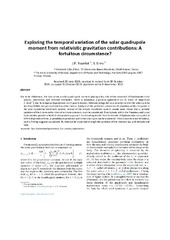Exploring the temporal variation of the solar quadrupole moment from relativistic gravitation contributions: A fortuitous circumstance?
Permanent lenke
https://hdl.handle.net/10037/18382Dato
2019-11-08Type
Journal articleTidsskriftartikkel
Peer reviewed
Sammendrag
Due to its oblateness, the Sun carries a solar quadrupole moment playing a key role at the crossroad of fundamental solar physics, astrometry and celestial mechanics. There is nowadays a general agreement on its order of magnitude (
≈2×10-7
), but its temporal dependence is still poorly known. Helioseismology led to a variation within the solar cycle by less than 0.04%, not yet confirmed by other means. Analysis of the perihelion precession of planetary orbits computed in the solar equatorial coordinate system, instead of the ecliptic coordinate system usually used, shows that a periodic variation of the
J2
term rather than of a simple constant, must be considered. Gravity tests within the Planetary and Lunar Ephemerides provide a fruitful independent approach. Confronting results from three sets of Ephemerides computed at different periods of time, a variability dependence within the solar cycle can be evidenced. If this outcome is not fortuitous, such a finding suggests a quadratic fit, that can be explained through the variation of the rotation law with latitude and time.
Forlag
ElsevierSitering
Rozelot, J.P.; Eren, S. (2019) Exploring the temporal variation of the solar quadrupole moment from relativistic gravitation contributions: A fortuitous circumstance?. Advances in Space Research, 15, 12, 2821-2827Metadata
Vis full innførselSamlinger
© 2019 COSPAR. Published by Elsevier Ltd. All rights reserved


 English
English norsk
norsk